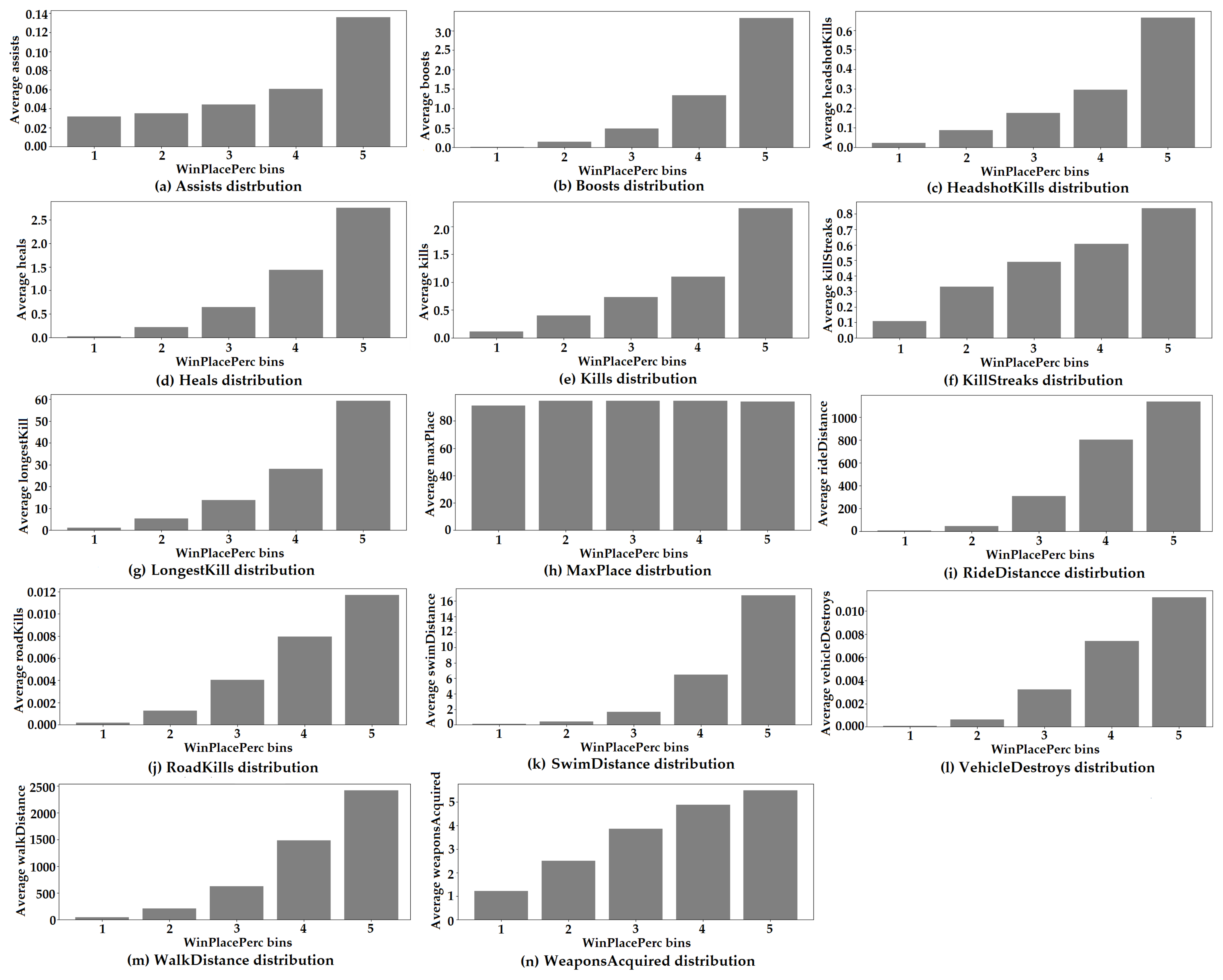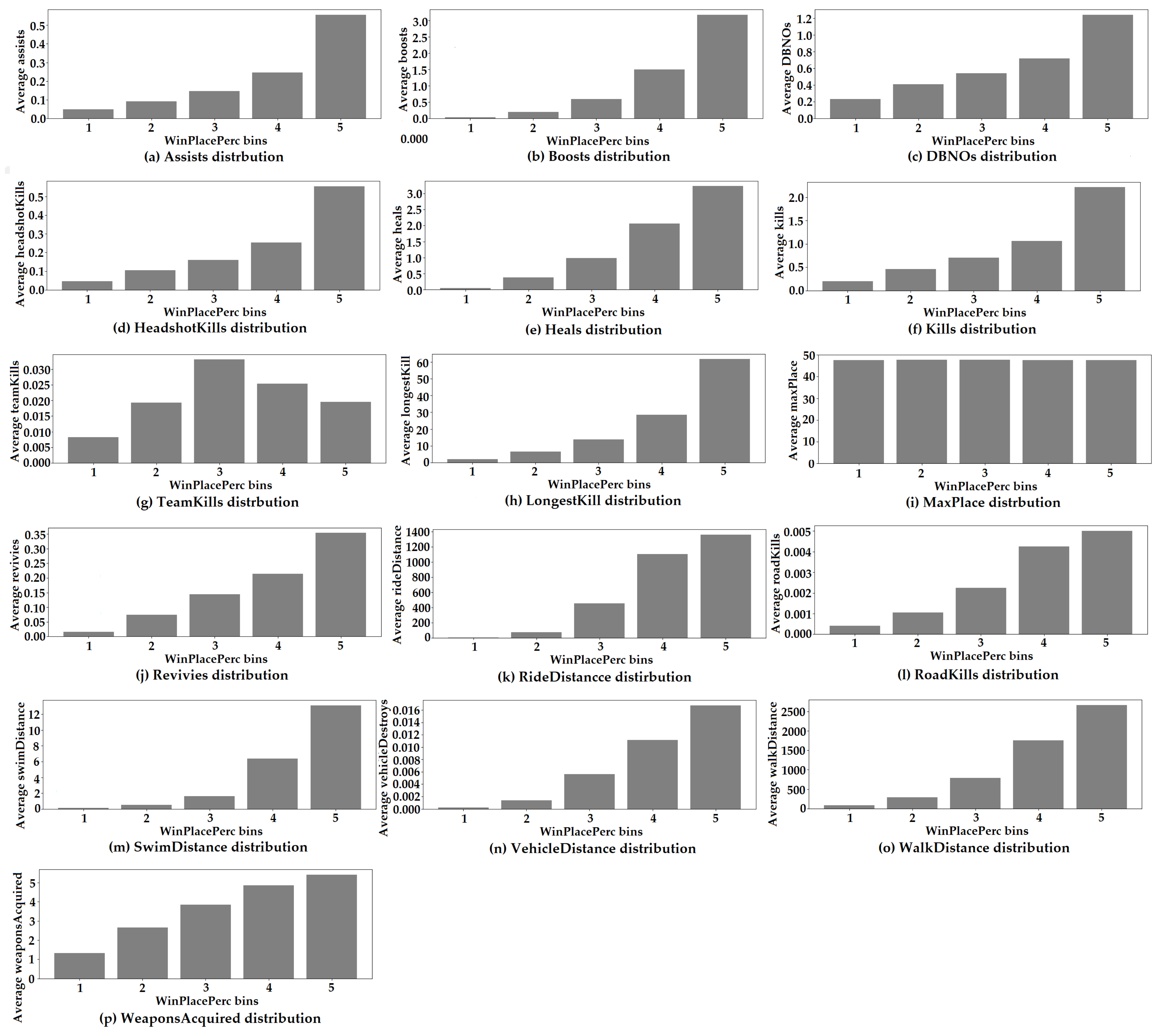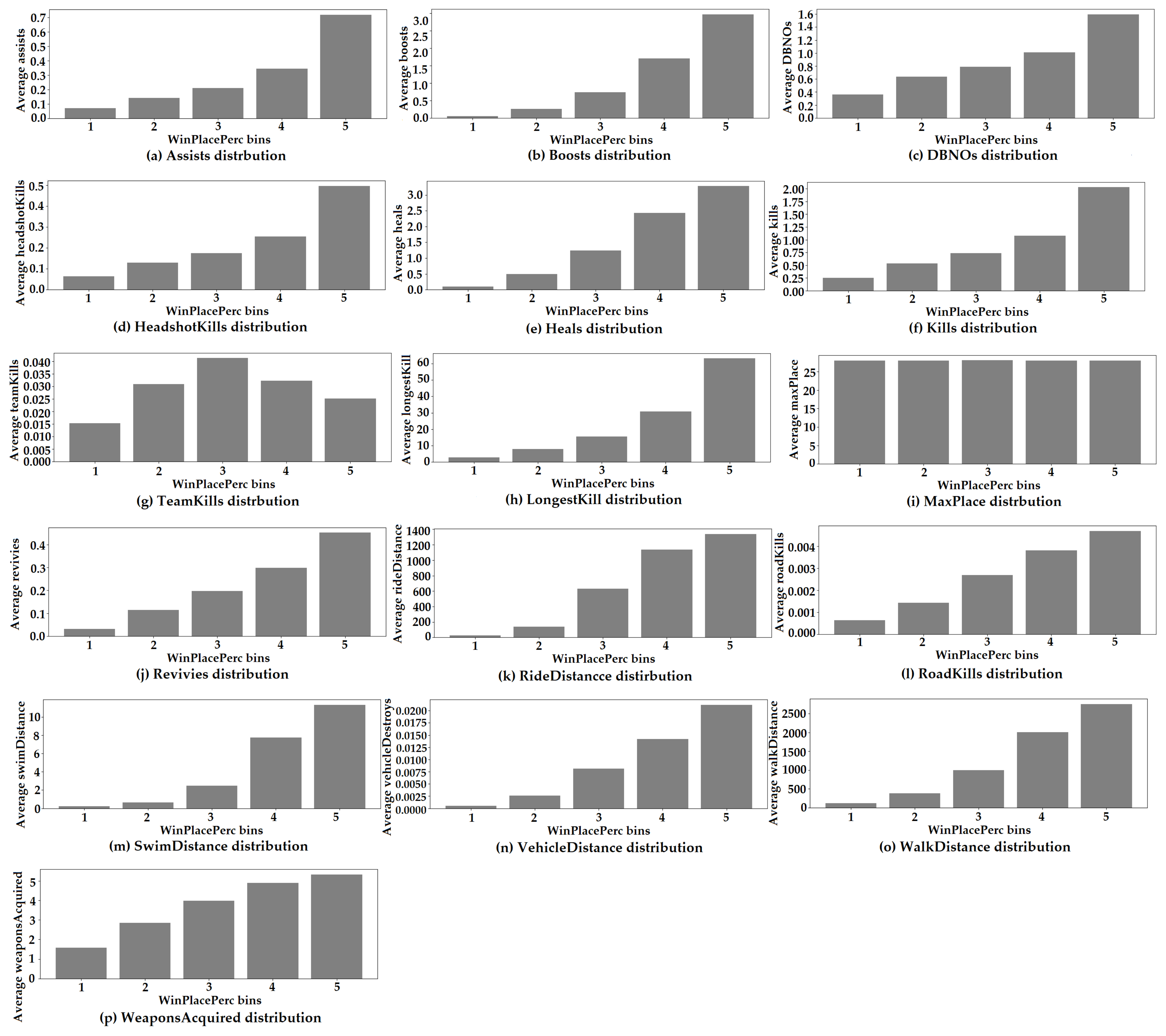A Study on the Factors Influencing Rank Prediction in PlayerUnknown’s Battlegrounds
Abstract
1. Introduction
- First, to enhance the accuracy of rank prediction in PUBG by leveraging data analysis and machine learning techniques, thereby identifying generalizable patterns that can be applied to other battle royale games.
- Second, to provide actionable insights for game developers regarding game mechanics, balancing, and design improvements, while simultaneously offering personalized strategic recommendations to players. This dual focus aims to improve player performance and elevate the overall user experience in competitive gaming environments.
2. Study Backgrounds
2.1. Related Works
2.2. Machine Learning Methods
3. Materials and Methods
3.1. Database
3.2. PUBG Game Data Preprocessing
3.3. Variables Selection Method
4. Results
4.1. Exporatory Data Analysis (EDA)
4.2. Performances of Machine Learning Methods
5. Discussion
6. Conclusions
Author Contributions
Funding
Institutional Review Board Statement
Data Availability Statement
Conflicts of Interest
References
- Kim, J.; Lee, T. How to Activate eSports Using Mobile App Review Analysis: Focusing on Mobile Battlegrounds. Korea Sport Soc. 2023, 21, 27–42. [Google Scholar] [CrossRef]
- Xu, Z.; Xiang, M.; Pang, L. Study on the influence factors of college students’ loyalty in PUBG game. IOP Conf. Ser. Mater. Sci. Eng. 2018, 439, 032059. [Google Scholar] [CrossRef]
- Gwak, Y.H.; Kim, H.N. A Study on e-Sports of BattleGround Game. In Proceedings of the Korean Society of Computer Information Conference, Incheon, Republic of Korea, 4 June 2018; Volume 26, pp. 104–105. [Google Scholar]
- Kang, H.N.; Kang, H.R.; Hwang, H.S. An Analysis of Game Strategy and User Behavior Pattern Using Big Data: Focused on Battlegrounds Game. J. Korea Game Soc. 2019, 19, 27–35. [Google Scholar] [CrossRef]
- Park, C.I. A Study on Immersion Degree of Players Depending on Figurative Characteristics of Game Characters. Soc. Digit. Policy Manag. 2020, 18, 271–276. [Google Scholar]
- Song, D.H. Analysis of User Transfer of Successful Battle Royale Games—From Player Unknown’s Battleground to Fortnite. J. Korea Inst. Inf. Commun. Eng. 2020, 24, 71–76. [Google Scholar]
- Park, H.M.; Byun, H.W. Battle Recommendation Algorithm for Player unknown’s Battleground Game. J. Digit. Contents Soc. 2018, 19, 2067–2076. [Google Scholar] [CrossRef]
- Kim, J.H. Study on Predictive Factors for League of Legends Game Churn Using Match Record Data. J. Korea Game Soc. 2023, 23, 67–79. [Google Scholar] [CrossRef]
- Shin, S.; Lee, S.; Jun, C.; Lee, K. BattleSound: A Game Sound Benchmark for the Sound-Specific Feedback Generation in a Battle Game. Sensors 2023, 23, 770. [Google Scholar] [CrossRef]
- Chung, S.; Kim, J.S.; Song, D.H. A Comparative Analysis of First Person Shooter Games on Battle Style and Equipment/Skill Patterns—Overwatch vs A.V.A. Online vs Battleground. In Proceedings of the 2017 Autumn Conference of the Korean Institute of Information and Communication Sciences, Jeju, Republic of Korea, 4–7 July 2017; Volume 10, pp. 443–446. [Google Scholar]
- Gilles, L. Understanding Random Forests: From Theory to Practice. arXiv 2014, arXiv:1407.7502. [Google Scholar]
- Breiman, L. Random Forests. Mach. Learn. 2001, 45, 5–32. [Google Scholar] [CrossRef]
- Zhigang, S.; Guotao, W.; Pengfei, L.; Hui, W.; Min, Z.; Xiaowen, L. An improved random forest based on the classification accuracy and correlation measurement of decision trees. Expert Syst. Appl. 2024, 237, 121549. [Google Scholar]
- Iskandaryan, D.; Ramos, F.; Palinggi, D.A.; Trilles, S. The Effect of Weather in Soccer Results: An Approach Using Machine Learning Techniques. Appl. Sci. 2020, 10, 6750. [Google Scholar] [CrossRef]
- Breiman, L. Bagging predictors. Mach. Learn. 1996, 24, 123–140. [Google Scholar] [CrossRef]
- Keskar, N.S.; Socher, R. Improving Generalization Performance by Switching from Adam to SGD. arXiv 2017, arXiv:1712.07628. [Google Scholar]
- Bottou, L. Stochastic gradient descent tricks. In Neural Networks: Tricks of the Trade; Springer: Berlin/Heidelberg, Germany, 2012; pp. 421–436. [Google Scholar]
- Ndou, N.; Nontongana, N. Performance Evaluation of Gradient Descent Optimizers in Estuarine Turbidity Estimation with Multilayer Perceptron and Sentinel-2 Imagery. Hydrology 2024, 11, 164. [Google Scholar] [CrossRef]
- Bhattacharjee, P.; Augustyniak, P. Comparative Evaluation of Neural Network Models for Optimizing ECG Signal in Non-Uniform Sampling Domain. Appl. Sci. 2024, 14, 8772. [Google Scholar] [CrossRef]
- Lee, J.Y. Experimental Evaluation of Deep Learning Methods for an Intelligent Pathological Voice Detection System Using the Saarbruecken Voice Database. Appl. Sci. 2021, 11, 7149. [Google Scholar] [CrossRef]
- Evangelista, L.; Móller, D.; Brentan, B.; Meirelles, G. Application of Feedforward Artificial Neural Networks to Predict the Hydraulic State of a Water Distribution Network. Eng. Proc. 2024, 69, 49. [Google Scholar] [CrossRef]
- Chen, T.; Guestrin, C. XGBoost: A Scalable Tree Boosting System. In Proceedings of the 22nd ACM SIGKDD International Conference on Knowledge Discovery and Data Mining, San Francisco, CA, USA, 13–17 August 2016; ACM: San Francisco, CA, USA, 2016; pp. 785–794. [Google Scholar]
- Ke, G.; Meng, Q.; Finley, T.; Wang, T.; Chen, W.; Ma, W.; Ye, Q.; Liu, T.-Y. LightGBM: A Highly Efficient Gradient Boosting Decision Tree. In Proceedings of the 31st International Conference on Neural Information Processing Systems, Long Beach, CA, USA, 4–9 December 2017. [Google Scholar]
- Kaggle. Available online: https://www.kaggle.com (accessed on 15 January 2025).
- Marcoulides, K.M.; Raykov, T. Evaluation of Variance Inflation Factors in Regression Models Using Latent Variable Modeling Methods. Educ. Psychol. Meas. 2019, 79, 874–882. [Google Scholar] [CrossRef]
- Maksymilian, W.; Ke, C. Feature Importance Ranking for Deep Learning. arXiv 2020, arXiv:2010.08973v1. [Google Scholar]
- Gałka, P.; Strzelecki, A. How Randomness Affects Player Ability to Predict the Chance to Win at PlayerUnknown’s Battlegrounds (PUBG). Comput. Games J. 2021, 10, 1–18. [Google Scholar] [CrossRef]
- Dehpanah, A.; Ghori, M.F.; Gemmell, J.; Mobasher, B. The Evaluation of Rating Systems in Team-based Battle Royale Games. arXiv 2021, arXiv:2105.14069. [Google Scholar]





| Variables | Details |
|---|---|
| DBNOs | Number of enemy players knocked. |
| assists | Number of enemy players this player damaged that were killed by teammates. |
| boosts | Number of boost items used. |
| damageDealt | Total damage dealt. Note: Self-inflicted damage is subtracted. |
| headshotKills | Number of enemy players killed with headshots. |
| heals | Number of healing items used. |
| Id | Player’s ID. |
| killPlace | Ranking in match of number of enemy players killed. |
| killPoints | Kills-based external ranking of player (think of this as an Elo ranking where only kills matter). If there is a value other than −1 in rankPoints, then any 0 in killPoints should be treated as a “None”. |
| killStreaks | Max number of enemy players killed in a short amount of time. |
| kills | Number of enemy players killed. |
| longestKill | Longest distance between player and player killed at time of death. This may be misleading, as downing a player and driving away may lead to a large longestKill stat. |
| matchDuration | Duration of match in seconds. |
| matchId | ID to identify match. There are no matches that are in both the training and testing set. |
| matchType | String identifying the game mode that the data come from. The standard modes are “solo”, “duo”, “squad”, “solo-fpp”, “duo-fpp”, and “squad-fpp”; other modes are from events or custom matches. |
| rankPoints | Elo-like ranking of player. This ranking is inconsistent and is being deprecated in the API’s next version, so use with caution. Value of −1 takes place of “None”. |
| revives | Number of times this player revived teammates. |
| rideDistance | Total distance traveled in vehicles measured in meters. |
| roadKill | Number of kills while in a vehicle. |
| swimDistance | Total distance traveled by swimming measured in meters. |
| teamKills | Number of times this player killed a teammate. |
| vehicleDestroy | Number of vehicles destroyed. |
| walkDistance | Total distance traveled on foot measured in meters. |
| weaponsAcquired | Number of weapons picked up. |
| winPoints | Win-based external ranking of player (think of this as an Elo ranking where only winning matters). If there is a value other than −1 in rankPoints, then any 0 in winPoints should be treated as a “None”. |
| groupId | ID to identify a group within a match. If the same group of players plays in different matches, they will have a different groupId each time. |
| numGroups | Number of groups for which data are available in the match. |
| maxPlace | Worst placement for which data are available in the match. This may not match with numGroups, as sometimes the data skip over placements. |
| winPlacePerc | The target of prediction. This is a percentile winning placement, where 1 corresponds to first place, and 0 corresponds to last place in the match. It is calculated using maxPlace, not numGroups, so it is possible to have missing chunks in a match. |
| Solo Match | Duo and Squad Matches | |
|---|---|---|
| Variables | VIF | VIF |
| DBNOs | • | 3.339270 |
| assists | 1.231543 | 1.299453 |
| boosts | 2.372591 | 2.522598 |
| damageDealt | 10.900117 | 6.746104 |
| headshotKills | 2.069419 | 1.825589 |
| heals | 1.378487 | 1.520519 |
| killPlace | 11.294659 | 10.331870 |
| killStreaks | 5.201883 | 6.759149 |
| kills | 12.549613 | 8.567932 |
| longestKill | 1.861507 | 1.774739 |
| revives | • | 1.161692 |
| rideDistance | 1.203800 | 1.258768 |
| roadKill | 1.036510 | 1.013335 |
| swimDistance | 1.040075 | 1.035366 |
| teamKills | • | 1.025467 |
| vehicleDestroy | 1.017098 | 1.032305 |
| walkDistance | 3.363026 | 3.647383 |
| weaponsAcquired | 1.772671 | 1.758946 |
| maxPlace | 1.814989 | 1.131704 |
| winPlacePerc | 7.368751 | 7.042226 |
| Solo Matches | Duo Matches | Squad Matches | |
|---|---|---|---|
| Input variables: 14 | Input variables: 17 | Input variables: 17 | |
| assists, boosts, headshotKills, heals, killStreaks, kills, longestKill, rideDistance, roadkill, swimDistance, vehicleDestroy, walkDistance, weaponsAcquired, maxPlace | assists, boosts, headshotKills, heals, killPlace, kills, longestKill, rideDistance, roadkill, swimDistance, vehicleDestroy, walkDistance, weaponsAcquired, maxPlace, DBNOs, revives, teamKills | assists, boosts, headshotKills, heals, killPlace, kills, longestKill, rideDistance, roadkill, swimDistance, vehicleDestroy, walkDistance, weaponsAcquired, maxPlace, DBNOs, revives, teamKills | |
| Random forest (RF) | n_estimators = 300, min_samples_leaf = 3, max_features = ‘sqrt’ | n_estimators = 80, min_samples_leaf = 3, max_features = ‘sqrt’ | n_estimators = 80, min_samples_leaf = 3, max_features = ‘sqrt’ |
| Gradient descent (GD) | n_estimators = 300, learning_rate = 0.1, max_depth = 6 | n_estimators = 300, learning_rate = 0.1, max_depth = 6 | n_estimators = 300, learning_rate = 0.1, max_depth = 6 |
| Extreme gradient boosting (XGBoost) | objective = ‘reg:squarederror’, tree_method = ‘gpu_hist’, predictor = ‘gpu_predictor’ colsample_bytree = 0.8, learning_rate = 0.001, max_depth = 5, n_estimators = 50,000, subsample = 0.8 | objective = ‘reg:squarederror’, tree_method = ‘gpu_hist’, predictor = ‘gpu_predictor’ colsample_bytree = 0.8, learning_rate = 0.01, max_depth = 5, n_estimators = 9000, subsample = 0.8 | objective = ‘reg:squarederror’, tree_method = ‘gpu_hist’, predictor = ‘gpu_predictor’ colsample_bytree = 0.8, learning_rate = 0.1, max_depth = 5, n_estimators = 1000, subsample = 0.8 |
| Feedforward neural network (FNN) | two hidden layers, activation function = relu, optimizer = adam, number of epochs = 10,000, learning rate = 0.001 | two hidden layers (hidden_size1 = 64, hidden_size2 = 32), activation function = relu, optimizer = sgd, number of epochs = 100, batch_size = 500, learning rate = 0.01 | five hidden layers (hidden_size1 = 64, hidden_size2 = 32, hidden_size3 = 32, hidden_size4 = 16, hidden_size5 = 8), activation function = relu, optimizer = adam, number of epochs = 100, batch_size = 500, learning rate = 0.001 |
| Solo Matches | Duo Matches | Squad Matches | |
|---|---|---|---|
| Random forest (RF) | 87.67% | 84.24% | 78.21% |
| Gradient descent (GD) | 88.05% | 84.75% | 77.32% |
| Extreme gradient boosting (XGBoost) | 88.07% | 84.73% | 77.27% |
| Feedforward neural network (FNN) | 87.96% | 84.55% | 77.19% |
Disclaimer/Publisher’s Note: The statements, opinions and data contained in all publications are solely those of the individual author(s) and contributor(s) and not of MDPI and/or the editor(s). MDPI and/or the editor(s) disclaim responsibility for any injury to people or property resulting from any ideas, methods, instructions or products referred to in the content. |
© 2025 by the authors. Licensee MDPI, Basel, Switzerland. This article is an open access article distributed under the terms and conditions of the Creative Commons Attribution (CC BY) license (https://creativecommons.org/licenses/by/4.0/).
Share and Cite
Lee, J.-N.; Lee, J.-Y. A Study on the Factors Influencing Rank Prediction in PlayerUnknown’s Battlegrounds. Electronics 2025, 14, 626. https://doi.org/10.3390/electronics14030626
Lee J-N, Lee J-Y. A Study on the Factors Influencing Rank Prediction in PlayerUnknown’s Battlegrounds. Electronics. 2025; 14(3):626. https://doi.org/10.3390/electronics14030626
Chicago/Turabian StyleLee, Ji-Na, and Ji-Yeoun Lee. 2025. "A Study on the Factors Influencing Rank Prediction in PlayerUnknown’s Battlegrounds" Electronics 14, no. 3: 626. https://doi.org/10.3390/electronics14030626
APA StyleLee, J.-N., & Lee, J.-Y. (2025). A Study on the Factors Influencing Rank Prediction in PlayerUnknown’s Battlegrounds. Electronics, 14(3), 626. https://doi.org/10.3390/electronics14030626





